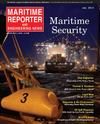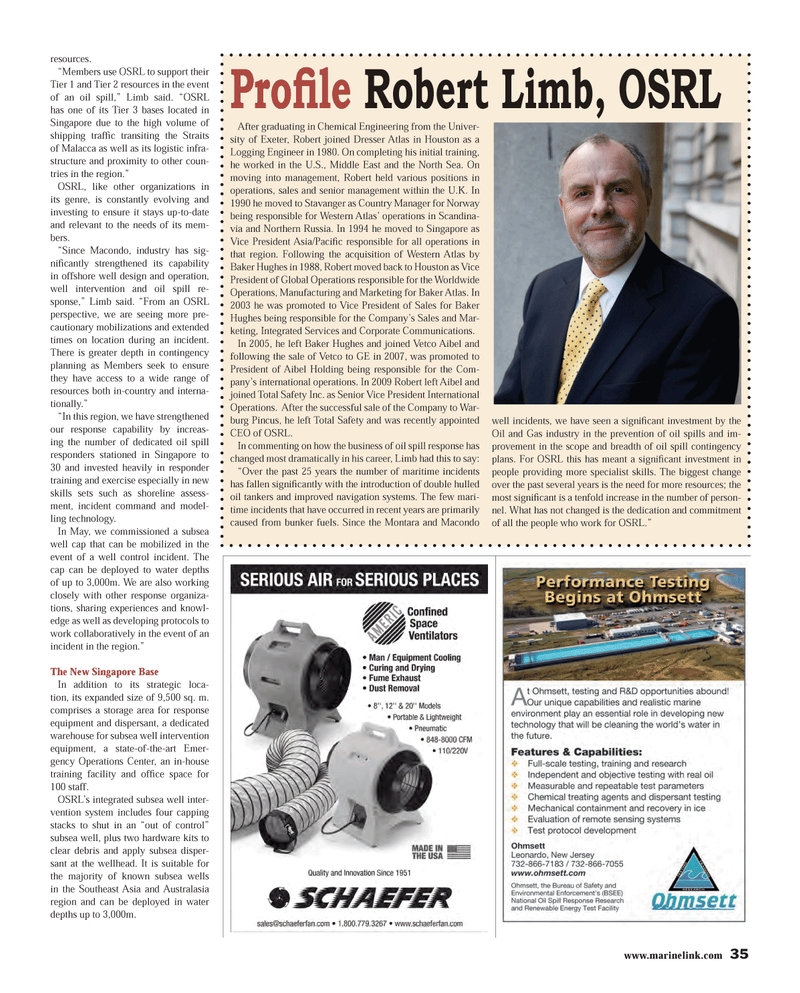
Page 35: of Maritime Reporter Magazine (July 2013)
Maritime Security Edition
Read this page in Pdf, Flash or Html5 edition of July 2013 Maritime Reporter Magazine
www.marinelink.com 35resources. ?Members use OSRL to support their Tier 1 and Tier 2 resources in the event of an oil spill,? Limb said. ?OSRL has one of its Tier 3 bases located in Singapore due to the high volume of shipping trafÞ c transiting the Straits of Malacca as well as its logistic infra-structure and proximity to other coun-tries in the region.?OSRL, like other organizations in its genre, is constantly evolving and investing to ensure it stays up-to-date and relevant to the needs of its mem-bers.?Since Macondo, industry has sig-niÞ cantly strengthened its capability in offshore well design and operation, well intervention and oil spill re-sponse,? Limb said. ?From an OSRL perspective, we are seeing more pre-cautionary mobilizations and extended times on location during an incident. There is greater depth in contingency planning as Members seek to ensure they have access to a wide range of resources both in-country and interna-tionally.? ?In this region, we have strengthened our response capability by increas-ing the number of dedicated oil spill responders stationed in Singapore to 30 and invested heavily in responder training and exercise especially in new skills sets such as shoreline assess-ment, incident command and model-ling technology. In May, we commissioned a subsea well cap that can be mobilized in the event of a well control incident. The cap can be deployed to water depths of up to 3,000m. We are also working closely with other response organiza- tions, sharing experiences and knowl-edge as well as developing protocols to work collaboratively in the event of an incident in the region.?The New Singapore Base In addition to its strategic loca-tion, its expanded size of 9,500 sq. m. comprises a storage area for response equipment and dispersant, a dedicated warehouse for subsea well intervention equipment, a state-of-the-art Emer-gency Operations Center, an in-house training facility and ofÞ ce space for 100 staff. OSRL?s integrated subsea well inter- vention system includes four capping stacks to shut in an ?out of control? subsea well, plus two hardware kits to clear debris and apply subsea disper- sant at the wellhead. It is suitable for the majority of known subsea wells in the Southeast Asia and Australasia region and can be deployed in water depths up to 3,000m.After graduating in Chemical Engineering from the Univer- sity of Exeter, Robert joined Dresser Atlas in Houston as a Logging Engineer in 1980. On completing his initial training, he worked in the U.S., Middle East and the North Sea. On moving into management, Robert held various positions in operations, sales and senior management within the U.K. In 1990 he moved to Stavanger as Country Manager for Norway being responsible for Western Atlas? operations in Scandina- via and Northern Russia. In 1994 he moved to Singapore as Vice President Asia/Paci Þ c responsible for all operations in that region. Following the acquisition of Western Atlas by Baker Hughes in 1988, Robert moved back to Houston as Vice President of Global Operations responsible for the Worldwide Operations, Manufacturing and Marketing for Baker Atlas. In 2003 he was promoted to Vice President of Sales for Baker Hughes being responsible for the Company?s Sales and Mar- keting, Integrated Services and Corporate Communications. In 2005, he left Baker Hughes and joined Vetco Aibel and following the sale of Vetco to GE in 2007, was promoted to President of Aibel Holding being responsible for the Com- pany?s international operations. In 2009 Robert left Aibel and joined Total Safety Inc. as Senior Vice President International Operations. After the successful sale of the Company to War- burg Pincus, he left Total Safety and was recently appointed CEO of OSRL.In commenting on how the business of oil spill response has changed most dramatically in his career, Limb had this to say: ?Over the past 25 years the number of maritime incidents has fallen signiÞ cantly with the introduction of double hulled oil tankers and improved navigation systems. The few mari- time incidents that have occurred in recent years are primarily caused from bunker fuels. Since the Montara and Macondo well incidents, we have seen a signiÞ cant investment by the Oil and Gas industry in the prevention of oil spills and im-provement in the scope and breadth of oil spill contingency plans. For OSRL this has meant a signi Þ cant investment in people providing more specialist skills. The biggest change over the past several years is the need for more resources; the most signiÞ cant is a tenfold increase in the number of person- nel. What has not changed is the dedication and commitment of all the people who work for OSRL.?ProÞ le Robert Limb, OSRLMR #7 (34-42).indd 35MR #7 (34-42).indd 357/1/2013 1:35:46 PM7/1/2013 1:35:46 PM

 34
34

 36
36
